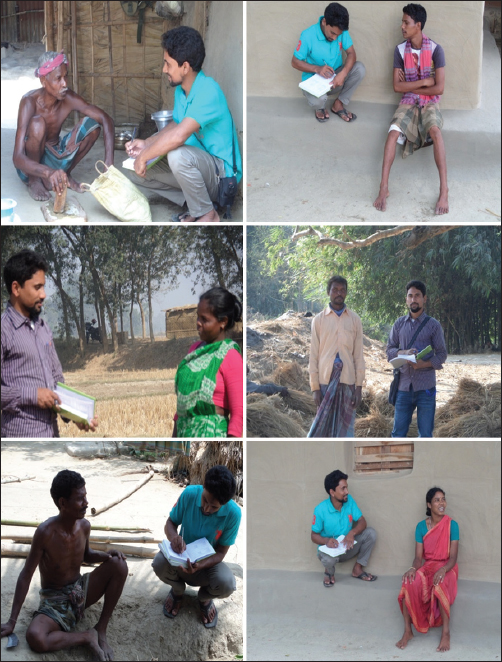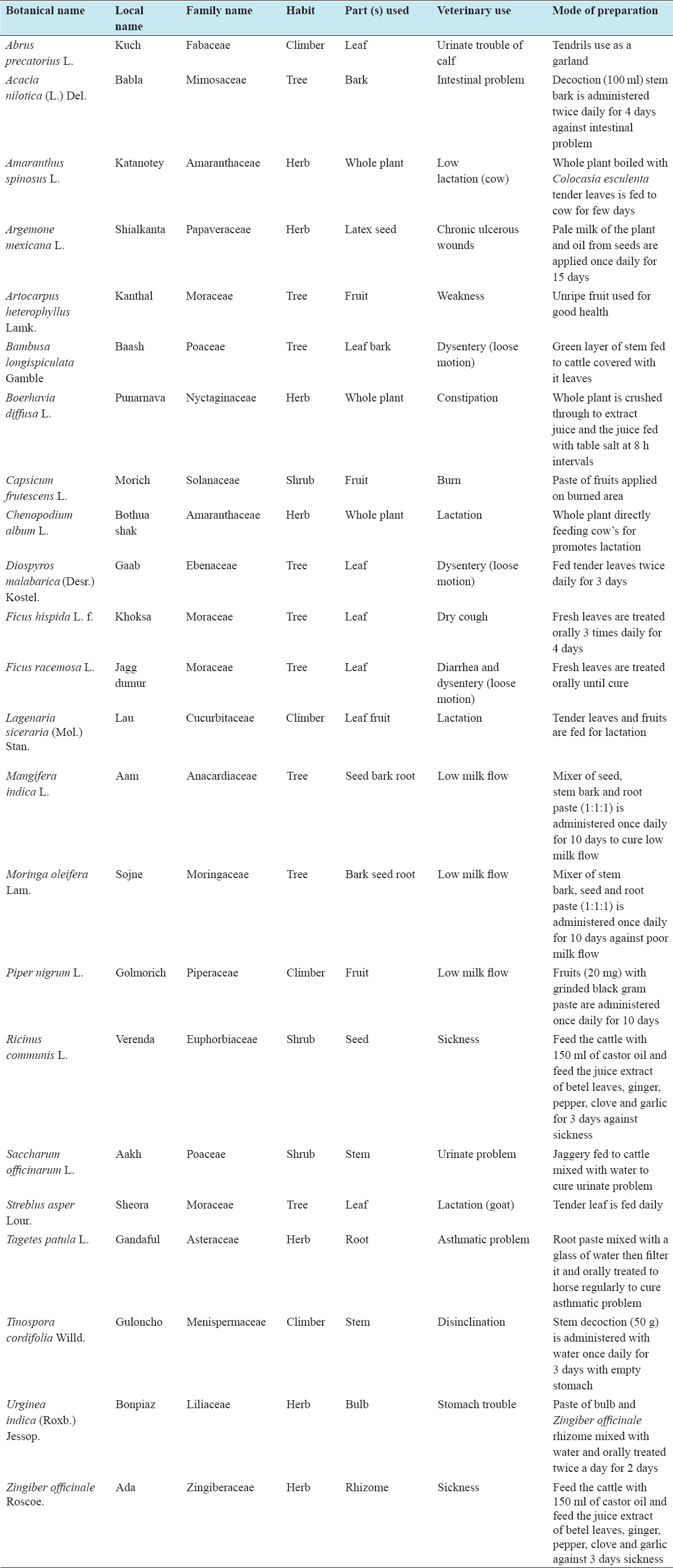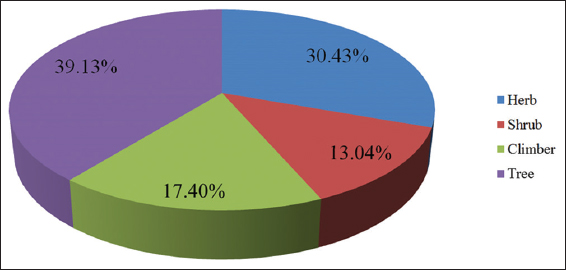INTRODUCTION
Nature is provided with a lot of herbal medicinal plants which play a major part in the treatment of diseases. Plants are considered as the significant and elemental sources of medicinal traits. Medicinal plants form the richest entity in medicines, food supplements, nutraceutical, pharmaceutical, and chemical industries for manufacturing drugs.[19] Ethnoveterinary medicine is the science that studies the beliefs, knowledge, techniques, methods, and practices used in the care and promotion of animal health.[6] Some factors, such as the increased cost of veterinary services and difficulty of acquiring synthetic drugs, have contributed to the interest in developing this science, especially regard to the use of phytotherapy.[18] Ethnoveterinary knowledge is acquired by communities over many years and passed between generations through oral tradition. Today, with rapid cultural changes, this knowledge is being lost, necessitating its scientific documentation [17]. There have been many ethnoveterinary surveys from around the world regarding the use of plants in therapeutic protocols.[2,7,8,11,12,15,16,23-26]
Plants with curative properties enjoy the utmost consideration in indigenous systems of medicine throughout the world. This is especially true in the developing countries, where imported drugs are very expensive and are, therefore, inaccessible to the vast majority of the population.[11] The searches for drugs and dietary supplements derived from plants have accelerated in recent years. Pharmacologists, microbiologists, botanists, and natural-products chemists are combing the earth for phytochemicals and lead that it could be developed for the treatment of various diseases. Knowledge of the curative properties of specific plants is an accomplished art. This art is still maintained in Bangladesh, especially in rural areas. Bangladesh is endowed with more than 5000 plant species, and about 1000 of them is medicinally important.[9]
In this context, it is important to conduct studies that document the ethnoveterinary knowledge of Santal communities, as rapid urbanization, the dominance of allopathic medicine and the acculturation of the population may contribute to the disappearance of such knowledge. In addition, popular knowledge can provide important information for the selection of natural alternatives for treating animal diseases and contribute to the discovery of new drugs. Therefore, the purpose of this study was to document and analyze the ethnoveterinary knowledge of the Santal community at Tanore Upazila of Rajshahi District, Bangladesh.
MATERIALS AND METHODS
Study Area
Tanore is an Upazila of Rajshahi District in the Division of Rajshahi, Bangladesh. Tanore Upazila area is 293.37 km2 located in 30 km northwest position from Rajshahi District. It is bounded by Nachole Upazila on the northwest, on the north Niamatpur, on the south Godagari, on the west Nawabganj sadar, on the northeast Manda and on the east Mohanpur Upazila. The climate of this area is generally tropical wet and dry climate, characterized by high temperatures, heavy monsoon, moderate rainfall, and high humidity. The hot season commences early in March and continues till the middle of July. The maximum mean temperature observed is about 32–36°C during the months of April, May, June, and July and the minimum temperature recorded in January is about 7–16°C. The highest rainfall is observed during the months of monsoon. The annual rainfall in the district is about 1,407 mm.[4]
Data Collection
A total of 19 field trips were made for the documentation of ethnoveterinary knowledge during April 2016–March 2017. During the field interview, the information was noted in the documentation data sheet. A total of 127 Santal people having an age range 24–73 years were interviewed using the semi-structured interviewed method.[3] Professionally they were peasant, day labor, farmer, housewives, small shopkeepers, etc. Among them, 58 were female and rest 69 were male. Regular field studies were made in the study area during the period. The information about the plants used for various diseases was gathered through interviews and discussion with the elderly people, medicine men and traditional medical practitioners were also consulted. Plant specimens were collected with flowers and fruits and processed using standard herbarium techniques.[3]
Plant Identification
The identification of plant specimens was achieved through the help of taxonomic experts and by comparison with the identified herbarium specimens and available literature.[1,10,14,20,22] The voucher specimens are deposited at the Herbarium, Department of Botany, Rajshahi University, Bangladesh, for future [Figure 1].
Figure 1: Interview with Santal people in the study area
RESULTS AND DISCUSSION
In this study, a total of 23 plant species under 22 genera and 17 families have been identified as potential source for treating 14 types of ailments. The scientific names of the species along with families, vernacular names, part(s) used, veterinary uses, doses, and mode of preparation are recorded [Table 1]. Out of these plants species, 30.43% belonged to herbs, 39.13% trees, 13.04% shrubs, and 17.40% climbers [Figure 2]. Use of plant parts as medicine shows variation. Leaves 30.43% are the leading part used in a majority of medicinal plants followed by whole plant 13.04%, bark 17.39%, seed 17.39%, bulb 4.35%, root 13.04%, stem 13.04%, latex 4.35%, and rhizome 4.35% [Figure 3]. The collected information is comparable with the result of other studies in Bangladesh and abroad. A total of 22 genera and 22 species were recorded in Northern Ethiopia.[26] A total of 43 species belonged to 41 genera and 31 families were recorded in Pabna District, Bangladesh.[2] A total of 57 medicinal plants and 37 families were recorded in Dinajpur District, Bangladesh.[12] A total of 51 plant species and 17 families were recorded in Bagerhat District, Bangladesh.[23] A total of 44 plant species and 32 families were recorded in Jessore District, Bangladesh.[15] A total of 56 species belonged to 49 genera and 35 families were recorded in Eastern Amazon, Brazil.[24] A total of 73 medicinal plants belonging to 70 genera and 45 families were recorded in Uttarakhand, India.[21] A total of 53 species belonging to 37 families was recorded in Chapai Nawabganj District, Bangladesh.[13] So far the information available, no published data recorded on the ethnoveterinary medicinal plants used in Tanore Upazila of Rajshahi District, Bangladesh.
Table 1: Recorded plant species used by the Santals for the treatment of veterinary diseases
Figure 2: Habit of the recorded plant species in the study area
Figure 3: Recorded plant parts used for veterinary purpose
CONCLUSION
The present study contributed to the establishment of an inventory of plants used in ethnoveterinary practices in the study area. Future, phytochemical and pharmacological studies are needed to confirm the efficacy and safety of the identified plants, enabling communities to use them in a more economic, effective, and safe manner.




